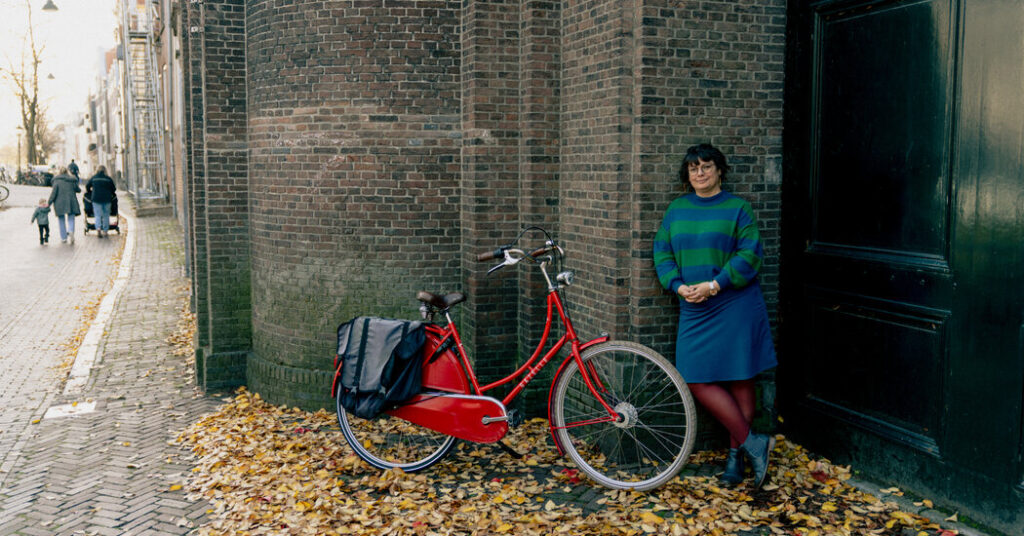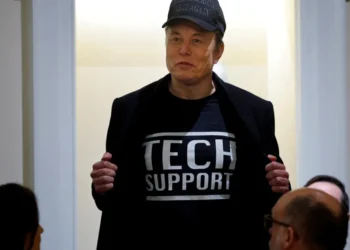This article is part of a Women and Leadership special report highlighting women who have forged new paths.
Melissa Bruntlett fell in love with cycling as a child. Now, at 45, she works to make cities around the world more bike-friendly and less car-dependent.
As an urban mobility advocate and adviser, she helps organizations develop equitable, inclusive and sustainable mobility through Modacity Creative, a consultancy she founded (the name intentionally rhymes with audacity). She often collaborates with her husband, Chris Bruntlett, and they are co-authors of several books, including the recently published “Women Changing Cities: Global Stories of Urban Transformation.”
Inspired by the Netherlands’ safe and robust cycling culture, Ms. Bruntlett, a native of Canada, moved to Delft with her husband and two children in 2019. She was interviewed by phone, and the conversation has been edited for length and clarity.
How did your interest in mobility begin?
I’ve been cycling since I was about five years old. I grew up in a middle-class household in Ontario with one car. Once I was able to cycle alone — the best way to get around my suburban town — I kept on doing it into adulthood. After moving to Vancouver in 2007, when the city was investing in cycling infrastructure, my husband and I made the decision to start riding around by bike with our kids. Seeing Vancouver on two wheels or hauling a trailer made our connection with each other and the city special. I had that moment: “There’s something to this. I feel a lot better. I’m a lot healthier. That’s something people should know more about.”
How did you transition from working in fashion to advocating sustainable mobility?
I started a blog called “Velo Family Diaries” to share the adventures I was having as a part-time working mom. I also started writing about cycling for a few publications on evenings and weekends. In 2014, I made the official shift. My husband and I started Modacity, a content creation channel to share photos, videos and writing to promote the many modes of urban mobility, and in early 2025 I founded Modacity Creative.
What is the scope of your work for Modacity Creative?
I focus on narrative building, storytelling and strategic planning, before the design happens. I do presentations and training, and I speak to groups about what’s happening in cities around urban transformation and how to apply their ideas. Recent projects include envisioning a new car-free zone in Amsterdam, creating an educational video series for the European Institute of Innovation and Technology and conducting a workshop in Vancouver to help participants think and communicate differently about the people who make up their communities and learn how to work collaboratively to develop solutions.
After visiting the Netherlands in 2016, why did you decide to move there?
My husband and I had been working in cycling advocacy for the better part of six years, referencing cycling-friendly cities in the Netherlands, but never having experienced them ourselves. We got an assignment to write a series of newspaper articles about five Dutch cities and how what we learned could apply in Vancouver. We visited Rotterdam, Eindhoven, Amsterdam, Utrecht and Groningen, which is famous as one of the first places that had a traffic circulation plan, and immersed ourselves in living in this Dutch environment. On our last day in the Netherlands, we said, “OK, kids, it’s time to go.” They cried. They had fallen in love with this life where it was safe to walk and we didn’t have to worry about the traffic.
We knew there was a bigger story to tell, which became “Building The Cycling City: The Dutch Blueprint for Urban Vitality.” It details how the country became this model for good cycling, and other places around the world where those ideas are being implemented. It’s to dispel this idea that what happens in the Netherlands can’t happen elsewhere. Our second book, “Curbing Traffic: The Human Case for Fewer Cars in Our Lives,” is based on our first year living in the Netherlands, and how we all benefit — regardless of our age, our gender, our ability, our socioeconomic status — when our cities are more balanced, where cars are not the dominant force.
Your recent book, “Women Changing Cities,” includes Mayor Anne Hidalgo of Paris, who worked to make the city less car-dependent. Who are some others?
There are 19 profiles in 11 locations, from Bogotá to Barcelona, of women whose accomplishments range from pedestrianizing busy streets and increasing public green spaces to implementing better public transport. Keisha Mayuga, a young woman in Manila, wanted to shift how people move in response to an increasing trend of women traveling several hours each day to and from work, missing valuable time with family, and launched a grass-roots campaign to put in protected bike lanes that has now expanded throughout the Philippines. Deputy Mayor Anuela Ristani of Tirana, Albania, spearheaded projects to give children safe spaces to play in a city that has grown rapidly and informally after the fall of communism.
What makes these organizations and cities run by women successful?
It’s not just because they’re women, it’s because they valued and prioritized certain ways of leading that ensured that things could get done, like understanding that you don’t have all the answers. There’s always something new to learn, and the only way we can know best how to serve is if we talk and we listen. Empathy and valuing caregiving work and how it functions in our society — key qualities that have made these women great leaders — have traditionally been considered feminine, but anyone can embrace them.
What has been the biggest challenge as a mobility advocate?
I’m not a designer, engineer or policymaker, so people don’t often know where I fit in. I have to find the right angle for people to understand what I do so I can help them. But it also means I can be more flexible and help in a lot of different ways.
What makes you most proud of your work?
Every time I meet somebody who says, “I read what you’ve done,” or “I’ve been following along,” and “it’s inspired me to change my life or start advocating my city.” The more people who understand these ideas and bring them to their daily work, the more impact we can have long term and the more value we can bring to the world around us.
The post She’s on a Mission to Make the World More Bike-Friendly appeared first on New York Times.




